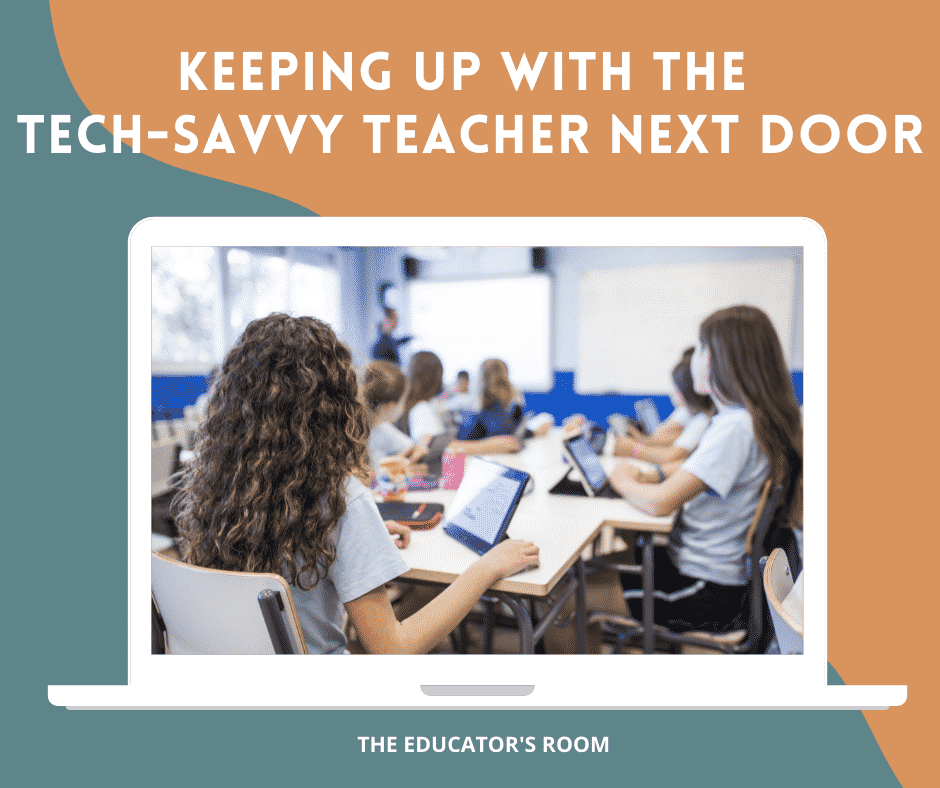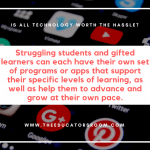Jerremiah Johnson
For years I’ve dabbled in technology integration within my classroom, or what I thought was integration. I taught my students to use Word documents and PowerPoint and eventually moved to Google docs and even shared assignments through a Google classroom. I thought I was doing the best I could all while keeping up with the latest classroom management techniques, managing IEPs, imputing grades, teaching the standards, and preparing my students for standardized testing. Yet, I couldn’t help but feel that my students were passing me up when it came to technology. It worried me, but I kept telling myself that I was already doing more than I could handle.
The social studies teacher down the hall started weekly Tech Tuesday sessions. I began attending in hopes that this would be the answer to my technology worries. However, each week I left feeling more and more overwhelmed. How was I going to find time to learn that new game? Which website would I choose? I didn’t have time to research them all. How many interactive tech tools did I need to keep students engaged? I couldn’t understand how he could possibly be teaching technology and teaching his content every day.
I spent too much time worrying about the tech integration (or lack of it) in my classroom. It was the struggle of knowing my students needed more technology and I needed to keep up with the times, yet I didn’t have enough time in the day to learn it all and there was so much to choose from. It was then that I stumbled across an interview with James Paul Gee on Grading with Games. His interview first captured my attention as it made me question the constant battle I was having with my own sons about playing video games, but something else he said really struck me.
“I think it can be a potential advantage (when teachers are not really as digitally savvy as their students) because if they’re learning along with their kids and modeling learning you have really a very good world for learning. Very often you don’t learn that much from an expert. You can learn a lot by learning with somebody else.”
Gee, 2008
I didn’t need to be the expert like the teacher down the hall, I could still master tech integration (with the help of my expert students) into my classroom without being completely overwhelmed.
“When students become a part of the planning and implementation of technology into the classroom, the burden is lifted from the teachers and the learning process becomes collaborative, with the teacher assuming the role of facilitator rather than a disseminator of information. Further, as students are actively involved in technology productions, they gain critical thinking and problem-solving skills along with curricular learning.”
Bazeli,1997
I’ve always been a huge believer in coaching students to take ownership in their own learning and providing them choices to keep their motivation high. I should have listened to my own beliefs, but I let my own intimidation get the best of me. I was supposed to be the expert (or I thought I was supposed to be) in all areas of student learning.
Integrating technology into the classroom doesn’t have to consume your entire planning period or take away from your content. Liz Kolb has provided a framework for educators to integrate technology into their pedagogy and content. Her framework ensures that the technology is not separate from the learning, it should engage the learners, enhance the learning goals, and extend the learning experience. Kolb’s “Triple E Framework” stresses the importance of lessons that allow students to use technology to meet learning goals and add value to the learning goals.
“Technology productions by students empower them to take some control over their own learning experiences and provide them with real-life, relevant learning experiences. Finally, the collaboration between teacher and student as such productions are developed allows the teacher to be a true facilitator of learning and enthusiastic guide for life-long learning skills.”
(Bazeli, 1997)
The way I see it, we as educators, are continually overwhelmed with the latest teaching strategies, data, test scores, managing student behaviors, new curriculums, assessments, and so much more. Yet, at the end of the day what we all really want is to produce motivated life-long longers who can creatively problem solve and think critically. I believe that we can do this by modeling that we as teachers really are lifelong learners as we learn and implement new technologies alongside our students. We can also encourage the independence and motivation of our kids by providing them with opportunities to choose appropriate technology tools to demonstrate their learning all the while increasing their critical thinking and improving communication and cooperative skills.
So the next time you walk into the classroom next door and see your coworker presenting some new tech lesson, don’t worry. No need to put unnecessary pressure on yourself, you’ve got a classroom full of students to teach you and learn with you. You don’t need to be the teacher next door after all.

References:
Bazeli, M. (1997) Visual Productions and Student Learning.
Kolb, L. (2019) http://tripleeframework.weebly.com
Gee, J (2008) Big Thinkers, James Paul Gee on Grading with Games. https://www.edutopia.org/video/big-thinkers-james-paul-gee-grading-games




